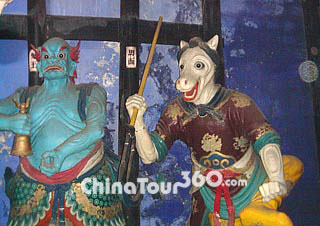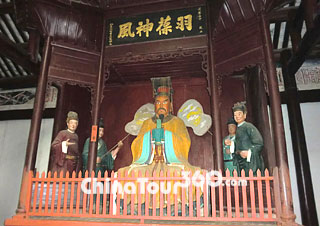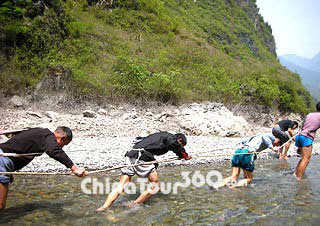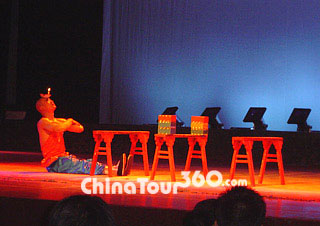 Ghost Culture in Fengdu City
Ghost Culture in Fengdu City Baidi City, Fengjie
Baidi City, Fengjie Trackers in Shennong Stream
Trackers in Shennong Stream Folk Show in Wanxian County
Folk Show in Wanxian County
Originating from the Qinghai-Tibet Plateau, traversing from west to east through 11 provinces, autonomous regions, and municipalities in central China, the Yangtze River, the largest River in China, gives rise to splendid Yangtze culture. The Yangtze River Basin totals 1,800,000 square kilometers (694,894 square miles), which takes up 1/5 of the gross area of Chinese land and 1/83 of land in the world. The population of Yangtze River Basin reaches 400,000,000, taking up 1/3 of the Chinese and 1/15 of the world’s people. The average population density of Yangtze River Basin now exceeds 220 per square kilometer (569 per square mile). Shanghai, the famous international city, becomes China's most crowded area with a population density of 4,600 per square kilometer (11,913 per square mile).
As is the Yellow River, the Yangtze River is also the cradle of Chinese civilization. Over 2 million years ago, the ancestors of the Chinese people lived along the Yangtze River and created a unique Yangtze River culture. They cultivated the earliest rice in the world, and invented the worlds’ oldest boat. Their excellent technique of salt mining was known to the world. People also created exquisite jade crafts and built up cities along the Yangtze River.
Cultural Relics: Countless precious historical sites and cultural relics have been discovered along the Yangtze River. In the upper reaches of the Yangtze River, more than 10 ancient human sites were unearthed. The most famous one is the Mt. Wushan Daxi cultural site, where relics from middle to later periods of Neolithic Period have been uncovered. In the middle reaches of the river, sites of the Neolithic Period are spread all over the Hanjiang River area and the world’s earliest rice has been found in Jiangxi Province. In the lower reaches, famous Hemudu Cultural Site, Majiabang Cultural Site, and Liangzhu Cultural Site are the representatives of Neolithic culture.
Celebrities: Since ancient times, celebrities always had certain connections with the famous mountains or rivers. Stories of famous Chinese people such as Qu Yuan, Wang Zhaojun, and Zhang Fei are also an integral part of Yangtze River culture. The Yangtze River, also, often appeared in the art works of many Chinese artists, including Li Bai, Su Shi, and Bai juyi.
Culture Evolution: Due to distinct natural environment of the upper, middle and lower reaches of Yangtze River, so different forms of culture came into shape in these areas: Ba & Shu Culture in the upper reaches, Jing & Xiang Culture in the middle reaches, and Wu & Yue Culture in the lower reaches.
Folklore: Folklore about the Yangtze River is central to Yangtze River culture. The Chinese people told thousands of stories about the river, from the form of the river to certain tributaries or even a hill near the river, all showing their respect and love for the river.
Life Style: Life styles along the Yangtze River are different from other parts of China, including customs, cuisines, and residential houses.








